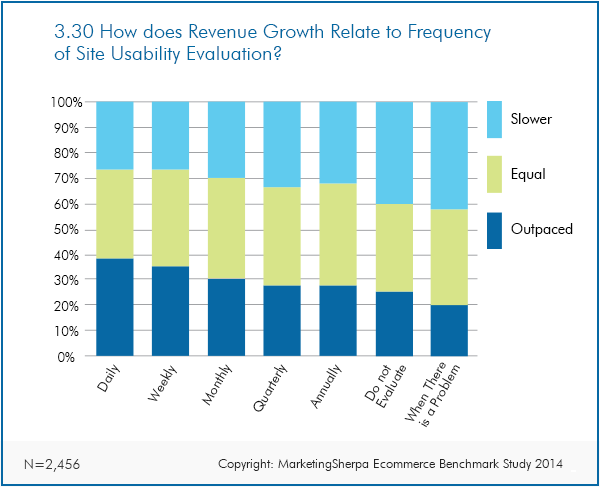by
Daniel Burstein, Director of Editorial Content
In the
2014 MarketingSherpa Ecommerce Benchmark Study survey, we asked …
Q. How often do you evaluate the following aspects of your webpages or templates? One of the aspects we asked about was ease of use.
We then compared the responses we received to responses from another survey question —
How did your revenue growth compare to your goals in 2013? — to construct the chart below:

Click here to see a printable version of this chart
It is better to be proactive about site usability than reactive
Companies that were reactive (only being concerned about ease of use when there was a problem) were less likely to meet revenue goals, with 40% of these marketers falling into the "slower than forecast revenue growth" group.
In contrast, the companies that evaluate ease of use frequently have a higher chance of being in the "rising revenue" group. For example, 39% of marketers who evaluate their site usability daily report that their company is outpacing its revenue growth goals.
Let's explore the two main challenges of running an easy-to-use ecommerce site to see why frequent monitoring is effective.
Understanding customer behavior
Some ecommerce companies simply do not know where their customers are struggling when it comes to navigating the website and checkout process — or even that customers are struggling to begin with.
One marketer responded to the Benchmark Study survey, saying that his company's challenges included " … usability and the lack of A/B testing."
Those two topics go hand in hand. First, companies must evaluate their website's usability.
Some tools at their disposal include:
- User testing
- Customer surveys
- Customer service feedback
- Funnel metrics analysis
- Conversion analysis
Second, companies can use these insights to formulate a hypothesis about how to improve usability (and conversion) and then discover what really works for their customers using A/B testing.
Since customers, websites, seasons, the competition, search engine algorithms, privacy regulations and many other factors are constantly changing, the more often companies conduct this customer-centric research, the more likely they will be able to serve customers with effective websites (and products as well).
Of course, it's not enough to know what works best for your customers. You then have to be able to execute, which is a challenge all on its own.
Overcoming technology hurdles
While the human marketer can use the above process to understand the best user experience, he or she must then use technology to implement those improvements, which is no small task.
Identifying the platform that will best enable ecommerce sites to serve customers, and then securing the budget for that platform, is just the beginning.
That new technology must then be implemented, which can be another large hurdle.
As one marketer responded in the Benchmark Study survey, "We upgraded our system, so we had a lot of bugs during the first few months of using the new system, and we also were not able to make usability improvements because of software and time limitations."
However, avoiding technology is not the answer. Many ecommerce sites are involved in a software arms race to more quickly implement solutions that better serve the customer. Unless your products clearly stand out from any other alternatives by being truly exceptional, the shopping and purchase experience may be the key differentiator between your offering and your competitors'.
To compete, the marketer must:
- Identify software and technology (or necessary site changes using current software) that will remove the hindrances identified in the customer research and testing mentioned above
- Attain the budget, not only for the software licenses but also for the IT (and Marketing) time and resources to implement and constantly improve the implementation
- Deploy a rigorous quality assurance (QA) testing process to ensure that any changes or software implementation on the production website is working properly and is ready to receive large amounts of traffic or purchases
- Continuously and proactively monitor the site (like the companies in the above chart that monitor website ease of use daily) for any bugs, hacks or conversion obstacles across the multiple devices that customers use, as one update somewhere on the site can have unintended ripple effects
Think beyond the website
Ease of use on the website itself is just the beginning. Truly successful ecommerce companies create a flawless customer experience throughout the entire buying cycle — from initial product exploration to product usage.
I think the ultimate goal for every ecommerce site can be best summed up by a marketer who responded to the Benchmark Study survey: "Excellent front-end usability combined with back-end fulfillment integration and process optimization will be key for ecommerce success in the years to come."
Related Resources
MarketingSherpa Ecommerce Benchmark Study — Made possible by a research grant from Magento, an eBay company
Ecommerce Research Chart: Discover your unique ecommerce success scoreEcommerce: Going beyond omnichannel for creative customer experiencesSocial Media Marketing: Tools and takeaways to implement todayEcommerce: How an online retailer achieved a 17% conversion lift with faster page loadingEcommerce: 3 vital marketing resources to explore before your next email send










